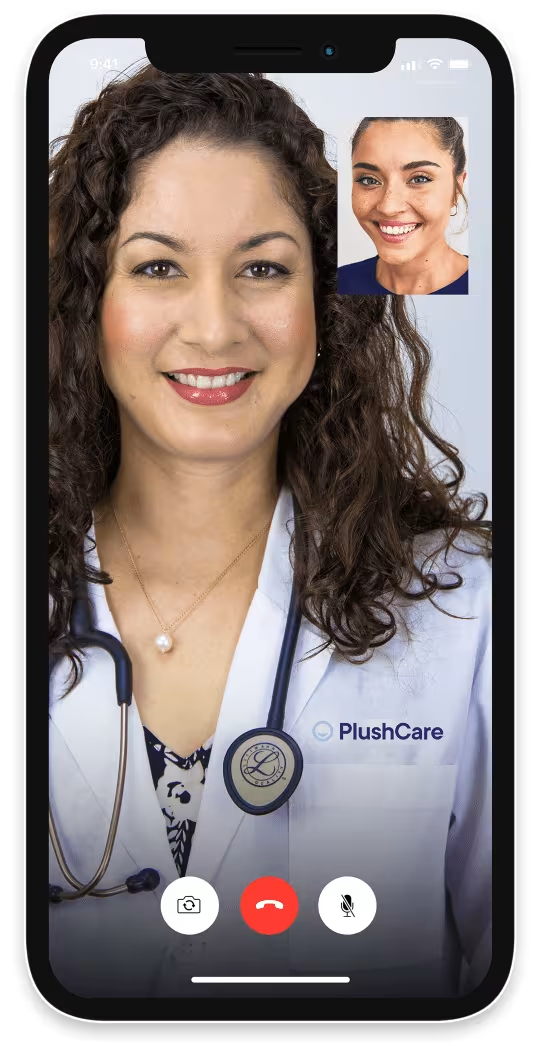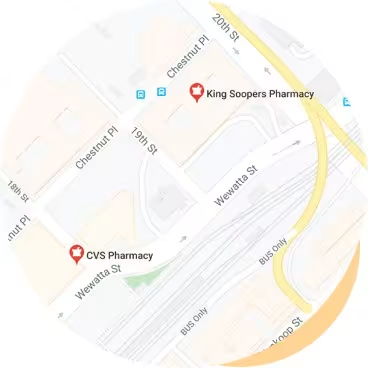- Chronic Care
Dyspnea
Dyspnea treatment available online today
To treat your dyspnea, consult with one of our board-certified primary care doctors online to get a prescription to help with shortness of breath. Get a new prescription to treat dyspnea or refill an existing prescription today.*
Book an appointmentExpert guidance for shortness of breath
Breathe better with doctor-recommended prescriptions
Tailored plans for chronic dyspnea
*Prescriptions are provided at the doctor's discretion. Learn more about our controlled substances policy and how to save up to 80% with our prescription discount card. PlushCare doctors cannot treat all cases of dyspnea. Our board-certified primary care physicians can conduct an initial evaluation of your symptoms but may need to refer you to a specialist or for in-person treatment. If you are experiencing life-threatening symptoms, seek in-person emergency medical attention immediately.

Learn about dyspnea
Dyspnea, or shortness of breath, happens when you feel like you can't breathe enough air into your lungs. During an episode of dyspnea, you may also experience chest pain or tightness, wheezing, generalized weakness and air hunger.
Dyspnea can be a sign of several chronic health conditions, including heart and lung conditions such as asthma, chronic obstructive pulmonary disease (COPD), or congestive heart failure (CHF). However, you can also experience acute or sudden onset of dyspnea from intense exercise, anxiety, allergies or more serious and potentially life-threatening conditions like a heart attack or pulmonary embolism. If you are experiencing new sudden onset difficulty breathing or severe worsening of chronic dyspnea, please seek in-person emergency care immediately.
Dyspnea causes
The most common cause of acute (short-term) dyspnea is exercise. After intense physical activity, you may have trouble breathing in enough oxygen to meet your body's demands. When this happens, breathing problems will typically go away with rest.
If you're at a higher elevation with less oxygen available, you may also experience acute dyspnea. Be sure to talk to your healthcare provider before exerting yourself at a higher elevation.
Dyspnea can also be a symptom of health problems. Some health conditions that cause chronic dyspnea include:Anemia
Heart failure
Lung disease
Low blood pressure (hypotension)
Respiratory infections, such as pneumonia
Pulmonary embolism (blood clot in the lungs)
Stress or anxiety
Idiopathic pulmonary fibrosis
Pulmonary hypertension
Cancer, especially lung cancer
Dyspnea symptoms
The main symptom of dyspnea is shortness of breath or labored breathing.
It's normal to have trouble breathing deeply for a few minutes after intense physical activity or exertion. In mild cases, you might feel like you're not getting enough air into your lungs. In severe cases, you might feel as though you're suffocating, what many people describe as “air hunger.”. Breathing problems can also coincide with chest pain.
If you experience shortness of breath when you're resting or during unexpected situations, you may have a serious medical condition. Chronic dyspnea can lead to:Difficulty breathing without any explanation
Trouble taking deep breaths after low-exertion activities
Feeling out of breath sooner than you used to after physical activity

How to treat dyspnea
The treatment for dyspnea depends on its underlying cause. Some effective treatment options for dyspnea include:
Diet and exercise: If you're obese or overweight, losing excess weight and eating a balanced diet can help reduce shortness of breath. If you have health problems that limit your activity, talk to one of our board-certified primary care physicians before starting a new exercise routine.
Pulmonary rehabilitation: COPD and other chronic lung conditions require specialized care from a pulmonologist. Depending on your condition, and if oxygen studies show you suffer from hypoxia or low blood oxygen levels, you may need oxygen therapy to improve lung function and relieve shortness of breath. This is typically determined by in-person care and consultation with a pulmonologist. If you do not have a pulmonologist, one of our primary care physicians can refer you to a specialist in your area.
Cardiac rehabilitation: Dyspnea is one of the symptoms of congestive heart failure. Cardiac rehabilitation is specialized in-person exercise therapy that can help you manage heart failure, heart disease, and related conditions. This is usually arranged and monitored by in-person care with a cardiologist. If you do not have a cardiologist, one of our primary care physicians can refer you to a specialist in your area.
Medications: Prescription medications, such as inhaled bronchodilators or inhaled steroids, can help relieve shortness of breath depending upon the underlying cause of the dyspnea.
Dyspnea medication
Depending on your medical history and the underlying cause of your dyspnea, your doctor may prescribe medications to improve symptoms. Helpful medications for dyspnea include:
Bronchodilators: If your lung function or airways are affected, your doctor may prescribe a bronchodilator to relax your airways. These are particularly helpful for people living with asthma or COPD. They can also provide relief for acute dyspnea triggered by allergic reactions or lung infections.
Corticosteroids: Steroids and other anti-inflammatory medications can help relieve pain and inflammation, especially in people with lung cancer and chronic lung diseases such as asthma and COPD.
Pain medications: Pain medications can help relieve dyspnea by decreasing your respiratory rate. These are only ever recommended for severe dyspnea associated with end-stage chronic heart or lung diseases and can only be prescribed by an in-person physician or hospice provider.
Anti-anxiety medications: Shortness of breath is a common symptom of anxiety disorders. If your shortness of breath happens due to anxiety, your doctor may prescribe anti-anxiety medications or antidepressants to manage mental and physical symptoms. Certain anti-anxiety medicines such as benzodiazepines (Xanax, Ativan, Klonopin) are controlled substances and cannot be prescribed by our physicians.

How to prevent dyspnea
Preventing shortness of breath requires avoiding or managing its possible causes:
Stop smoking. If you smoke, consider starting a smoking cessation program. For many people, cognitive behavioral therapy and smoking cessation medication can help with quitting. Speak with one of our board-certified primary care physicians to create a smoking cessation plan that is right for you.
Treat the underlying disease. Underlying illnesses, such as lung and heart conditions, can cause shortness of breath. Schedule regular doctor's appointments and follow your treatment plan to manage shortness of breath.
Avoid air pollution. Air pollution and environmental irritants can cause breathing problems. If your work environment has poor air quality, consider wearing a mask to filter out irritants.
Maintain a healthy weight. Being obese or overweight can increase your risk for several health conditions, including shortness of breath.

When to see a doctor for dyspnea
If you experience unexplained shortness of breath, see a doctor. Because shortness of breath can be a symptom of a serious health condition, you should always talk to a doctor about it.
Seek immediate medical attention if your shortness of breath is accompanied by:
Chest pain
Neck, jaw or arm pain
Fainting
Nausea or abdominal pain
A bluish tint in your lips or nails
Lightheadedness
These symptoms may be signs of a medical emergency, such as a heart attack. Call 911 or visit your nearest emergency room immediately.
Dyspnea treatment FAQs
What is the difference between shortness of breath and dyspnea?
Dyspnea is the medical term for shortness of breath. Dyspnea is often described as the feeling of breathlessness, chest tightness, difficulty breathing, or experiencing "air hunger."
What is the best treatment for dyspnea?
If underlying dangerous health conditions are not a concern, the best treatment for acute dyspnea is breathing exercises, such as:
Pursed lip breathing: Breathe deeply through your nose. Purse your lips and breathe out through your mouth slowly. Try counting to four as you inhale and exhale.
Abdominal breathing: Find your diaphragm (the dome-shaped muscle underneath your lungs). Inhale slowly, fill your lungs completely, and feel your stomach move away from you. Then, exhale, feel your stomach fall, and let your lungs empty.
If you have chronic dyspnea, your treatment will depend on the underlying cause of your shortness of breath. For example, if you're overweight, following a healthy diet and exercise plan can help reduce shortness of breath. Talk to your doctor if you're experiencing unexplained shortness of breath to determine the best treatment plan.Can dyspnea be cured?
Shortness of breath can occur for many reasons, and the underlying cause of dyspnea is not always curable. Home remedies, such as deep breathing or changing position, can help you breathe more easily. These are often learned through the process of pulmonary or cardiac rehabilitation therapy. Certain inhaled and oral medications may also help reduce or relieve shortness of breath.
How do you monitor dyspnea?
If your dyspnea is related to an underlying illness, your doctor may measure dyspnea to monitor your condition. Your doctor will ask you to rate the sensation of dyspnea as you perceive it on a scale from 0 to 4, where 0 indicates minor dyspnea and 4 indicates severe dyspnea. Your doctor may also ask you to monitor your blood oxygen levels with a finger-tip monitor called a pulse oximeter, or pulse ox for short. Your doctor may also ask you to check your peak flow measurements with a small peak flow device, which is especially helpful for people living with asthma.
What position is best for a patient with dyspnea?
If you experience shortness of breath, stand with your back near a wall and rest your hips against the wall. Then, rest your hands on your thighs and place your feet shoulder-width apart. Lean forward slightly, relax your shoulders, and slowly inhale and exhale.
3 simple steps to request a dyspnea consultation

Step 1
Book a dyspnea consultation appointment.
Book a same day appointment from anywhere.

Step 2
Talk to your board-certified primary care physician regarding your dyspnea concerns or symptoms.
Visit with a doctor on your smartphone or computer.

Step 3
If prescribed, pick up a prescription for treatment.
We can send prescriptions to any local pharmacy.
Related conditions to dyspnea
Allergies
Heart disease
Lung disease
Dyspnea consultation pricing details
How pricing works
To request dyspnea treatment, join our monthly membership and get discounted visits.
Paying with insurance
Membership
$16.99/month
First month free
Visits
Copay
30 days of free membership
Same-day appointments 7 days a week
Unlimited messages with your Care Team
Prescription discount card to save up to 80%
Exclusive discounts on lab tests
Free memberships for your family
Cancel anytime
Visit price with insurance
Often the same as an office visit. Most patients with in-network insurance pay $30 or less!
We accept these insurance plans and many more:
Paying without insurance
Membership
$16.99/month
First month free
Visits
$129
30 days of free membership
Same-day appointments 7 days a week
Unlimited messages with your Care Team
Prescription discount card to save up to 80%
Exclusive discounts on lab tests
Free memberships for your family
Cancel anytime
Visit price without insurance
Initial visits are $129.
If we're unable to treat you, we'll provide a full refund.
Dyspnea treatment resources
Sources:
PlushCare is dedicated to providing you with accurate and trustworthy health information.
Brigham and Women's Hospital. Dyspnea/Shortness of breath. Accessed on July 25, 2022. https://www.brighamandwomens.org/lung-center/diseases-and-conditions/dyspnea-shortness-of-breath
Cleveland Clinic. Shortness Of Breath (Dyspnea). Accessed on July 25, 2022. https://my.clevelandclinic.org/health/symptoms/16942-dyspnea
Mayo Clinic. Shortness of breath. Accessed on July 25, 2022. https://www.mayoclinic.org/symptoms/shortness-of-breath/basics/definition/sym-20050890
PlushCare content is reviewed by MDs, PhDs, NPs, nutritionists, and other healthcare professionals. Learn more about our editorial standards and meet the medical team. The PlushCare site or any linked materials are not intended and should not be construed as medical advice, nor is the information a substitute for professional medical expertise or treatment.